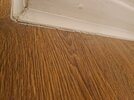- Joined
- 2 Jan 2022
- Messages
- 3
- Reaction score
- 0
- Country

Hello,
We have had laminate floorboards installed. The flat is in an old building so the floors are not even which means the floor trim is not flush with the floor. In addition, in certain areas the floorboards move down to leave a gap of up to 0.5mm when weight in applied.
We need to seal the gaps, as the building has had problems with cockroaches, so need to seal off gaps where we can.
To fill the gaps, pest control have applied silicon sealant but this is quite messy and is a trap for dust - so just looks terrible, especially when it starts to flake.
I'd appreciate any alternative suggestions. I am going to experiment with foam tape . Hopefully this would fit neatly under the gaps and and expand when weight is applied to the boards when weight is applied. Any views on this or any other alternatives would be greatly received.
Thanks!
We have had laminate floorboards installed. The flat is in an old building so the floors are not even which means the floor trim is not flush with the floor. In addition, in certain areas the floorboards move down to leave a gap of up to 0.5mm when weight in applied.
We need to seal the gaps, as the building has had problems with cockroaches, so need to seal off gaps where we can.
To fill the gaps, pest control have applied silicon sealant but this is quite messy and is a trap for dust - so just looks terrible, especially when it starts to flake.
I'd appreciate any alternative suggestions. I am going to experiment with foam tape . Hopefully this would fit neatly under the gaps and and expand when weight is applied to the boards when weight is applied. Any views on this or any other alternatives would be greatly received.
Thanks!

